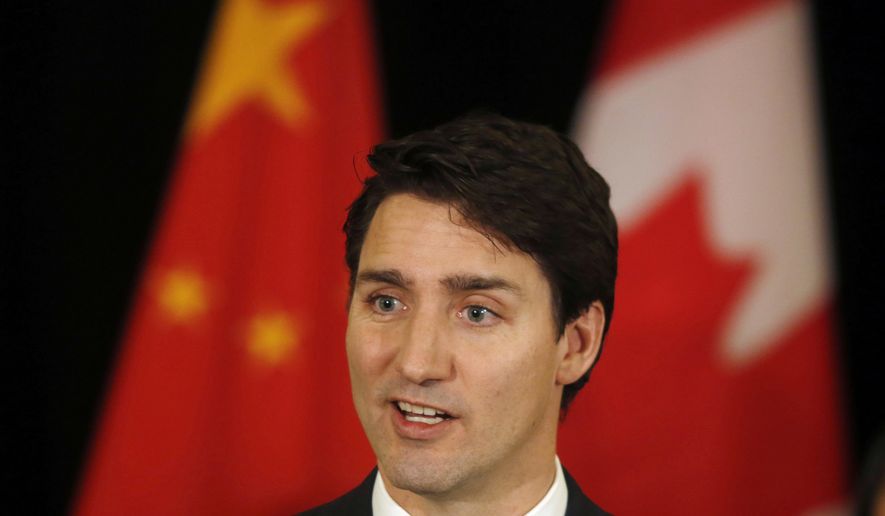TORONTO — Canada is dealing with its own problems with Beijing as President Trump prepares to sign phase 1 of his trade deal with China on Wednesday.
Some officials north of the border are worried that the U.S. deal will take pressure off Beijing to release Canadians imprisoned in China for over a year.
Canada’s relations with China, its second-largest trading partner after the U.S., have badly deteriorated as Ottawa tries to balance competing demands from Washington and Beijing. Several Canadians, including a well-known diplomat, have been languishing in Chinese prisons since their arrests after Canada detained Huawei’s Meng Wanzhou, one of China’s best-known tech executives, on an extradition request from the Trump administration.
Former Canadian diplomat Michael Kovrig and businessman Michael Spavor, both living in China, were arrested on Dec. 10, 2018, just days after Ms. Meng was detained. They remain in jail as Ms. Meng, the daughter of the founder of Huawei, prepares to fight extradition to the U.S.
In addition to the detentions of Canadian nationals, a furious Beijing cut its imports of Canadian canola, peas, pork and other meat.
Prime Minister Justin Trudeau faces a tough decision on whether to allow Huawei to build part of Canada’s 5G telecommunications infrastructure in the face of warnings from Washington that Huawei represents a security risk.
SEE ALSO: Schumer rips China trade agreement as result of 2020 campaign politics
All of this means hard times are in store for Canada and China, said Margaret McCuaig-Johnston, senior fellow at the University of Alberta’s China Institute.
“Canada is suffering in the wake of the U.S. extradition request, and the phase 1 deal will be another blow because pressuring China to buy more American agriculture means they will buy less from Canada. That hurts our farmers and reduces our influence,” she said. Canada has asked the U.S. to delay its phase 1 deal until the Canadians are released, but that doesn’t look likely, Ms. McCuaig-Johnston said.
Canada has even less leverage while it waits for the U.S. Congress to pass the updated North American Free Trade Agreement.
Chinese officials have openly mocked Canadian efforts to get U.S. help in their fight with China while warning Americans not to get involved.
“If you pull chestnuts out of the fire for others, you will end up being the one getting burned,” said Geng Shuang, a spokesperson for the Chinese Foreign Ministry.
Many Canadians worry that Mr. Trump’s confrontational trade stance with Beijing — and his willingness to cut a bilateral deal just for American producers — will end up hurting Canadian exporters.
The phase 1 deal “is bad news for Canada, and we can’t do a thing about it,” columnist Barrie McKenna wrote this week in the Toronto-based Globe and Mail newspaper.
Ratcheting up the pressure
China’s pressure on Canada has been growing in incremental steps.
Two other Canadians were arrested in China and charged with drug offenses that include the death penalty. In 2018, the fashion outlet Canadian Goose faced a short-lived boycott of its flagship store in China. While Huawei bids for a contract to expand telecommunications in Canada’s Far North and sell its equipment for the nation’s 5G network, China has declared itself a “near-Arctic nation” intent on claiming a piece of the Arctic’s resources even though it has no coastline there.
Ms. McCuaig-Johnston said Canada and the U.S. “share an interest in the Arctic and Arctic security,” but she worries that China plans to build military support structure in the Arctic and that the U.S. will not push back.
As the climate warms, the Northwest Passage — the waterway linking the Atlantic and Pacific Oceans through the Arctic — is becoming more commercially navigable. Canada considers this route inside its national boundaries because it runs through its Arctic island archipelago. However, the U.S. and China see the passage as international waters that they can freely transit with commercial and military vessels.
China’s behavior is “getting worse” with its militarization of the islands in the South China Sea and boldness in holding Canadians hostage, and countering that will be “a tricky challenge for Mr. Trudeau,” Ms. McCuaig-Johnston said.
Although much of the global economic growth in the past 30 years has been fueled by expanding global trade and interconnected trade networks, the U.S. and China are seeking ways to decouple that relationship, said Guy Saint-Jacques, former Canadian ambassador to China.
China has declared it wants to be a “model for the world” and decouple itself from its dependency on foreign suppliers, while at the same time Canada is pulling back from its plans to expand business with China while Canadian citizens remain in its jails, he said.
The battle over Huawei and 5G in Canada and Europe is forcing some global supply chains to choose between the two camps, Mr. Saint-Jacques added. That debate is also taking place in Canadian academic circles, where pressure from China is squelching criticism, he said.
Although the West would like to ensure China plays by its rules as it steps up as a global superpower, Chinese officials believe Mr. Trump needs a deal with them more than they need a deal with the U.S., he said.
Wesley Wark, a history professor at the University of Ottawa, told the CNBC financial news network that tensions are forcing the Trudeau government to walk a delicate tightrope balancing economic and national security interests.
“The government has to find a way to say, ’We are going to deal with the Huawei 5G case in its own dimension, in its own right,’” Mr. Wark told CNBC, “’and we are not going to use it as a tool of leverage or a tool of counterstrike against China itself.’”
Mr. Saint-Jacques said China’s strategy is comparable to that of the British Empire: economic domination coupled with gunboat diplomacy.
“We’re seeing the dark side of China,” he said.




Please read our comment policy before commenting.